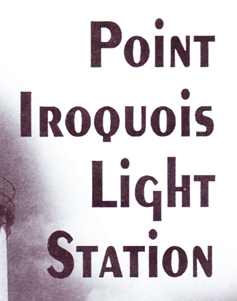Point Iroquois Light Station
Virtual brochure and information for Point Iroquois Light Station, one of many online travel brochures for tourist information in Sault Ste. Marie, MI. Provided by your source for Mackinaw Information and Mackinac Information.

Virtual PDF brochure of Point Iroquois Light Station
Hiawatha National Forest
USDA Forest Service
4000 I-75 Business Spur
Sault Ste. Marie, MI 49783
Phone: 906-635-5311
Keeping the Light
"Keeping the light" was a demanding job. Someone had to be on duty throughout the night during the shipping season. Prior to electricity, a large kerosene lamp provided the beacon’s light source. Keepers refilled the lamp with oil every four hours and the wicks needed constant trimming. Soot from the lantern’s flame had to be cleaned from the glass lens every day.
Despite hard work and long hours, life at Point Iroquois had advantages. Compared with more isolated stations, Point Iroquois offered space and a home-like atmosphere. Because of heavy ship traffic, in 1902 the Lighthouse Service added-on the dwelling originally built with the tower in 1870. The light station then had room for a head keeper, two assistants, and their families. They formed their own self-sustaining community, complete with a schoolhouse and a teacher for their children.
Dangerous Passage
Lake Superior, the deepest and coldest of the Great Lakes, was especially hazardous in this area because of bad weather conditions and the numerous ships leaving and approaching the Sault Ste. Marie locks.
The purpose of Point Iroquois Light Station was to guide freighters safely between the open waters of Whitefish Bay and the St. Mary’s River. The light station served passing sailors by marking the narrow channel between the shallow sand bars and shoals off Point Iroquois and the rocky reefs of Gros Cap on the Canadian side of the bay.
Even with the aid of the light and fog horn at Point Iroquois, ships occasionally foundered in the passage. Sixteen crewman lost their lives in the freezing lake when the Steamer Myron went down in 1919 during one of the infamous “storms of November.” Finding the bodies as they washed ashore, lightkeeper Elmer Byrnes took them to an undertaker in the nearby town of Brimley. The undertaker would pay $10 a piece for "floaters."
Original Point Iroquois Lens
In a Fresnel (pronounced "fray’-nel") lens many separate lenses work together to magnify and focus the light. The original Point Iroquois lens is now in the Smithsonian Institution.
Why the name "Point Iroquois?"
The area around Sault Ste. Marie ("The Soo"), including Whitefish Bay, has been called the "Heartland" of the Chippewa Indians. This tribe is also called Ojibwa, and sometimes refer to themselves as "Anishinabeg," which is their word for "original people." The Iroquois lived about 400 miles away, mostly in what is now western New York. In the 1600’s these nations were at war, at least in part because of European influence and fur trade competition. The Iroquois often sent expeditions far from their homeland and attempted to control the trade routes leading east from the Great Lakes.
Accounts of an important battle at Point Iroquois in 1662 have been passed down for over 300 years. They tell how an Iroquois war party camped near the point where the lighthouse now stands, and how the Chippewa secretly watched their movements and mounted a surprise attack near dawn. The Iroquois were defeated decisively, and apparently never again ventured this far west.
In 1662 a group of Iroquois traveled about 400 miles by canoe and foot from their homeland in western New York to the shores of Lake Superior. The local Chippewa defeated them in a battle fought near what is now call Point Iroquois.
Family photos from Point Iroquois, early 1950’s
In the early 1950’s, there were 3 families and eight children living at the lighthouse.
"It was a home, not just a station."
Keepers from Two Eras
Elmer Byrnes c. 1920
U.S. Lighthouse
Service Uniform
Gustav Zier c. 1950
U.S. Coast Guard
Uniform
Visiting Point Iroquois
Point Iroquois Light Station is located along the scenic Lake Superior shore in the Upper Peninsula of Michigan. It is only 20 miles west of Sault Ste. Marie and 51 miles east of Tahquamenon Falls. From birch bark canoes to giant ore freighters, this unique point of land has influenced travel for centuries.
Our museum reveals the stories of the lightkeepers and their families through family album photographs, antiques, and artifacts. Learn about the fourth order Fresnel lens that could project a light for sixteen miles. Climb the 72 steps to the top of the tower for a picturesque view of Lake Superior. Observe the freighters traveling through Whitefish Bay as you walk along a cobblestone beach in search of agates. Browse through our book shop, which offers a wide selection of historical readings about the Great Lakes.
Step back in time and visit our west wing exhibit. The assistant keeper’s apartment is restored to the way it looked in the early 1950’s. Imagine the smell of fresh cinnamon rolls or the sounds of "Suspense Theater" on the radio as you walk through.
Working Together... Caring for the Past...
Point Iroquois Light Station was placed on the National Register of Historic Places in 1975. Partially funded by donations and public contributions, the rehabilitation of this site was assisted by Bay Mills - Brimley Historical Research Society and other dedicated volunteers. The goal of all of those involved is to promote an awareness of the history of the Point Iroquois area.
Hiawatha National Forest
Providing opportunities for outdoor recreation is just one of the many goals of the Hiawatha National Forest. The Forest Service was originally established to protect watersheds and supply timber. Its responsibilities now include multiple-use management of all resources. Preserving this significant structure and interpreting local history are among the objectives of the Hiawatha National Forest in administering the Point Iroquois Light Station.
If you have new or updated information about this virtual brochure, please contact us.
 Post a Comment
Post a Comment
Reader Comments